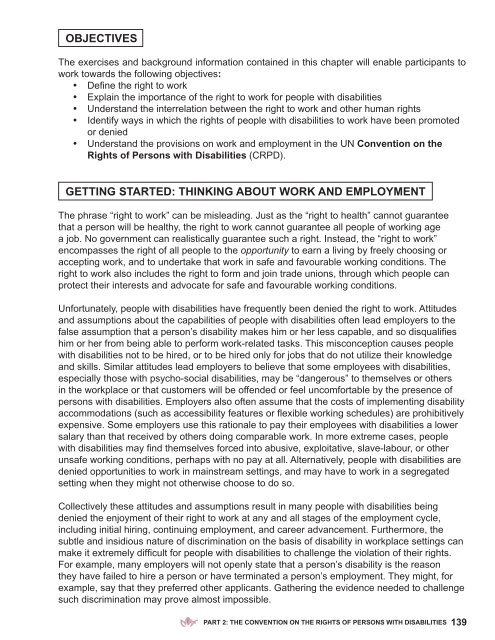Full page photo print - Harvard Law School Project on Disability
Full page photo print - Harvard Law School Project on Disability
Full page photo print - Harvard Law School Project on Disability
Create successful ePaper yourself
Turn your PDF publications into a flip-book with our unique Google optimized e-Paper software.
obJecTives<br />
The exercises and background informati<strong>on</strong> c<strong>on</strong>tained in this chapter will enable participants to<br />
work towards the following objectives:<br />
• Define the right to work<br />
• Explain the importance of the right to work for people with disabilities<br />
• Understand the interrelati<strong>on</strong> between the right to work and other human rights<br />
• Identify ways in which the rights of people with disabilities to work have been promoted<br />
or denied<br />
• Understand the provisi<strong>on</strong>s <strong>on</strong> work and employment in the UN c<strong>on</strong>venti<strong>on</strong> <strong>on</strong> the<br />
Rights of Pers<strong>on</strong>s with disabilities (CRPD).<br />
geTTing sTARTed: ThinKing AboUT woRK And emPloymenT<br />
The phrase “right to work” can be misleading. Just as the “right to health” cannot guarantee<br />
that a pers<strong>on</strong> will be healthy, the right to work cannot guarantee all people of working age<br />
a job. No government can realistically guarantee such a right. Instead, the “right to work”<br />
encompasses the right of all people to the opportunity to earn a living by freely choosing or<br />
accepting work, and to undertake that work in safe and favourable working c<strong>on</strong>diti<strong>on</strong>s. The<br />
right to work also includes the right to form and join trade uni<strong>on</strong>s, through which people can<br />
protect their interests and advocate for safe and favourable working c<strong>on</strong>diti<strong>on</strong>s.<br />
Unfortunately, people with disabilities have frequently been denied the right to work. Attitudes<br />
and assumpti<strong>on</strong>s about the capabilities of people with disabilities often lead employers to the<br />
false assumpti<strong>on</strong> that a pers<strong>on</strong>’s disability makes him or her less capable, and so disqualifies<br />
him or her from being able to perform work-related tasks. This misc<strong>on</strong>cepti<strong>on</strong> causes people<br />
with disabilities not to be hired, or to be hired <strong>on</strong>ly for jobs that do not utilize their knowledge<br />
and skills. Similar attitudes lead employers to believe that some employees with disabilities,<br />
especially those with psycho-social disabilities, may be “dangerous” to themselves or others<br />
in the workplace or that customers will be offended or feel uncomfortable by the presence of<br />
pers<strong>on</strong>s with disabilities. Employers also often assume that the costs of implementing disability<br />
accommodati<strong>on</strong>s (such as accessibility features or flexible working schedules) are prohibitively<br />
expensive. Some employers use this rati<strong>on</strong>ale to pay their employees with disabilities a lower<br />
salary than that received by others doing comparable work. In more extreme cases, people<br />
with disabilities may find themselves forced into abusive, exploitative, slave-labour, or other<br />
unsafe working c<strong>on</strong>diti<strong>on</strong>s, perhaps with no pay at all. Alternatively, people with disabilities are<br />
denied opportunities to work in mainstream settings, and may have to work in a segregated<br />
setting when they might not otherwise choose to do so.<br />
Collectively these attitudes and assumpti<strong>on</strong>s result in many people with disabilities being<br />
denied the enjoyment of their right to work at any and all stages of the employment cycle,<br />
including initial hiring, c<strong>on</strong>tinuing employment, and career advancement. Furthermore, the<br />
subtle and insidious nature of discriminati<strong>on</strong> <strong>on</strong> the basis of disability in workplace settings can<br />
make it extremely difficult for people with disabilities to challenge the violati<strong>on</strong> of their rights.<br />
For example, many employers will not openly state that a pers<strong>on</strong>’s disability is the reas<strong>on</strong><br />
they have failed to hire a pers<strong>on</strong> or have terminated a pers<strong>on</strong>’s employment. They might, for<br />
example, say that they preferred other applicants. Gathering the evidence needed to challenge<br />
such discriminati<strong>on</strong> may prove almost impossible.<br />
PART 2: The c<strong>on</strong>venTi<strong>on</strong> <strong>on</strong> The RighTs of PeRs<strong>on</strong>s wiTh disAbiliTies<br />
139




